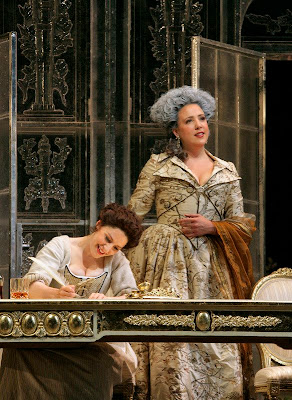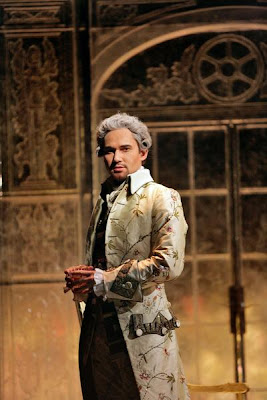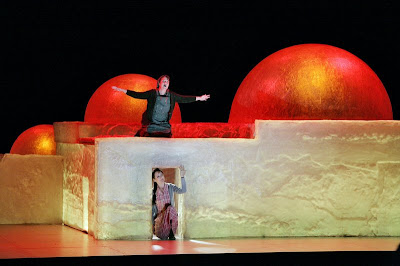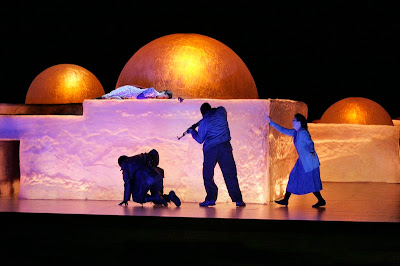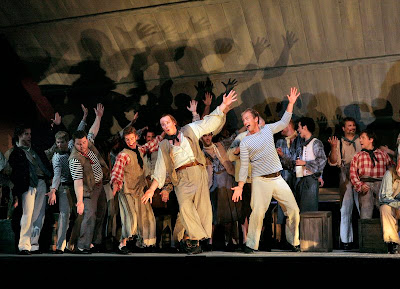Last month | Next monthClassical Month in Washington is a monthly feature. If there are concerts you would like to see included on our schedule, send your suggestions by e-mail (ionarts at gmail dot com). Happy listening!October 1, 2008 (Wed)
7:30 pmBizet,
The Pearl FishersWashington National OperaKennedy Center Opera House
October 2, 2008 (Thu)
7 pmNational Symphony OrchestraWith Hélène Grimaud (piano) and Miguel Harth-Bedoya (guest conductor)
Kennedy Center Concert Hall
October 2, 2008 (Thu)
7:30 pmVerdi,
La TraviataWashington National OperaKennedy Center Opera House
October 2, 2008 (Thu)
7:30 pmLe Cabaret de CarmenAmerican Opera Theater
Baltimore Theater ProjectOctober 3, 2008 (Fri)
7:30 pmLe Cabaret de CarmenAmerican Opera Theater
Baltimore Theater ProjectOctober 3, 2008 (Fri)
8 pmNational Symphony OrchestraWith Hélène Grimaud (piano) and Miguel Harth-Bedoya (guest conductor)
Kennedy Center Concert Hall
October 3, 2008 (Fri)
8 pmUniversity of Maryland Symphony and Wind Orchestra
With Larissa Dedova, piano
Clarice Smith Center
October 4, 2008 (Sat)
4 pmNew York PhilharmonicWPASKennedy Center Concert Hall
October 4, 2008 (Sat)
7 pmBizet,
The Pearl FishersWashington National OperaKennedy Center Opera House
October 4, 2008 (Sat)
7:30 pmVenice's Musical Circle
Countertop Ensemble and Washington Cornett and Sackbutt Ensemble
Universalist National Memorial Church (1810 16th St. NW)
October 4, 2008 (Sat)
7:30 pmLe Cabaret de CarmenAmerican Opera Theater
Baltimore Theater ProjectOctober 4, 2008 (Sat)
8 pmNational Symphony OrchestraWith Hélène Grimaud (piano) and Miguel Harth-Bedoya (guest conductor)
Kennedy Center Concert Hall
October 4, 2008 (Sat)
8 pmNational PhilharmonicBeethoven's 9th symphony
Music Center at Strathmore
October 5, 2008 (Sun)
2 pmKennedy Center Chamber PlayersMusic by Beethoven and Shostakovich
Kennedy Center Terrace Theater
October 5, 2008 (Sun)
2 pmVerdi,
La TraviataWashington National OperaKennedy Center Opera House
October 5, 2008 (Sun)
2 pmLe Cabaret de CarmenAmerican Opera Theater
Baltimore Theater ProjectOctober 5, 2008 (Sun)
3 pmNational PhilharmonicBeethoven's 9th symphony
Music Center at Strathmore
October 5, 2008 (Sun)
4 pmTrefor Smith, piano [FREE]
Phillips CollectionOctober 5, 2008 (Sun)
4 pmAmadeus Orchestra: Haydn and His Circle
With Jeffrey Chappell, piano
Amadeus ConcertsSt. Luke Catholic Church (McLean, Va.)
October 5, 2008 (Sun)
5:30 pmLeon Fleisher's 80th Birthday CelebrationWith Jonathan Biss, Yefim Bronfman, and Katherine Jacobson Fleisher
Shriver Hall (Baltimore, Md.)
October 5, 2008 (Sun)
6:30 pm)musica(aperta [FREE]
Mysticism in Spanish Renaissance music
National Gallery of ArtOctober 6, 2008 (Mon)
7 pmVerdi,
La TraviataDomingo-Cafritz Young Artists
Washington National Opera
Kennedy Center Opera House
October 7, 2008 (Tue)
12:10 pmNoontime Cantata:
Die Elenden sollen essen (BWV 75) [FREE]
Washington Bach ConsortChurch of the EpiphanyOctober 7, 2008 (Tue)
7:30 pmBizet,
The Pearl FishersWashington National OperaKennedy Center Opera House
October 8, 2008 (Wed)
7:30 pmConcertanteChamber music by Martinů, Dvořák, Tchaikovsky
Kennedy Center Terrace Theater
October 9, 2008 (Thu)
7:30 pmPatrick Bismuth (Baroque violin) and La Tempesta
La Maison FrançaiseOctober 9, 2008 (Thu)
7:30 pmJennifer Ellis Kampani (soprano) and J. Reilly Lewis (harpsichord)Mansion at Strathmore
October 10, 2008 (Fri)
8 pmAndrás Schiff, pianoAll-Beethoven program
WPAS
Music Center at StrathmoreOctober 11, 2008 (Sat)
11 amBaltimore Symphony Orchestra (Mozart, Schubert)
Ignat Solzhenitsyn, conductor
Meyerhoff Symphony Hall (Baltimore, Md.)
October 11, 2008 (Sat)
7 pmBritten,
Albert HerringCastleton Young Artist Residency
Châteauville Foundation (Castleton Farms, Va.)
October 11, 2008 (Sat)
8 pmCamerata SalzburgWith Anne-Sophie Mutter, violin
WPAS (Season Opening Celebration)
Kennedy Center Concert Hall
October 11, 2008 (Sat)
8 pmBaltimore Symphony OrchestraMusic by Rossini, Mendelssohn, Mozart
Music Center at Strathmore
October 12, 2008 (Sun)
1 and 3 pmNational Symphony OrchestraFamily Concert: Orchestra from Planet X
Kennedy Center Concert Hall
October 12, 2008 (Sun)
4 pmBritten,
Albert HerringCastleton Young Artist Residency
Châteauville Foundation (Castleton Farms, Va.)
October 12, 2008 (Sun)
4 pmMinju Choi, piano [FREE]
Phillips CollectionOctober 12, 2008 (Sun)
6:30 pmGilles Vonsattel, piano [FREE]
Music by Bach, Liszt, Muhly, Rorem, Schubert
National Gallery of ArtOctober 14, 2008 (Tue)
12:10 pmVasily Popov (cello) and Ralitza Patcheva (piano) [FREE]
Church of the EpiphanyOctober 15, 2008 (Wed)
12:10 pmMichele Campanella, piano
Music by Domenico Scarlatti
National Gallery of Art (East Building Auditorium)
October 15, 2008 (Wed)
7:30 pmTribute to RostropovichWith Rostropovich Foundation Scholarship winners
Kennedy Center Terrace Theater
October 16, 2008 (Thu)
7 pmSoldiers of Music: Rostropovich Returns to Russia (1991)
Documentary film screening [FREE]
Library of CongressOctober 16, 2008 (Thu)
7 pmNational Symphony OrchestraMahler, Third Symphony (Iván Fischer, conductor)
Kennedy Center Concert Hall
October 16, 2008 (Thu)
7:30 pmEdwin Good, pianoMansion at Strathmore
October 16, 2008 (Thu)
8 pmBaltimore Symphony OrchestraBernstein,
MassMeyerhoff Symphony Hall (Baltimore, Md.)
October 17, 2008 (Fri)
7:30 pmIBIS at the Movies [FREE]
IBIS Chamber Music SocietyLyon Park Community Center (Arlington, Va.)
October 17, 2008 (Fri)
8 pmCollegium Vocale Gent [FREE]
With Kristian Bezuidenhout, fortepiano
Library of CongressOctober 17, 2008 (Fri)
8 pmNational Symphony OrchestraMahler, Third Symphony (Iván Fischer, conductor)
Kennedy Center Concert Hall
October 17, 2008 (Fri)
8 pmBaltimore Symphony OrchestraBernstein,
MassMeyerhoff Symphony Hall (Baltimore, Md.)
October 17, 2008 (Fri)
8 pmEroica TrioBarns at Wolf Trap
October 17, 2008 (Fri)
8 pmVerdi,
Il TrovatoreVirginia OperaGeorge Mason University Center for Fine ArtsOctober 18, 2008 (Sat)
7 pmDomingo-Cafritz Young Artists,
The Unknown BizetWashington National Opera
La Maison FrançaiseOctober 18, 2008 (Sat)
8 pmNational Symphony OrchestraMahler, Third Symphony (Iván Fischer, conductor)
Kennedy Center Concert Hall
October 18, 2008 (Sat)
8 pmBaltimore Symphony OrchestraBernstein,
MassMeyerhoff Symphony Hall (Baltimore, Md.)
October 18, 2008 (Sat)
8 pmAxelrod QuartetMusic by Cherubini
Renwick Gallery
October 18, 2008 (Sat)
8 pmNational PhilharmonicWith Brian Ganz, piano
Music Center at Strathmore
October 18, 2008 (Sat)
8 pmTurtle Island String Quartet with Sérgio and Odair Assad: String Theory
George Mason University Center for Fine ArtsOctober 19, 2008 (Sun)
2 pmVerdi,
Il TrovatoreVirginia OperaGeorge Mason University Center for Fine ArtsOctober 19, 2008 (Sun)
3 pmMorris Robinson, bass [FREE]
National Academy of Sciences
October 19, 2008 (Sun)
4 pmAlexander Romanovsky, piano
Châteauville Foundation (Castleton Farms, Va.)
October 19, 2008 (Sun)
4 pmMirjana Rajić, piano [FREE]
Phillips CollectionOctober 19, 2008 (Sun)
4 pmIBIS at the Movies [FREE]
IBIS Chamber Music SocietyChurch of Clarendon (Arlington, Va.)
October 19, 2008 (Sun)
5:30 pmEwa Podleś (contralto) and Garrick Ohlsson (piano)Shriver Hall (Baltimore, Md.)
October 19, 2008 (Sun)
6:30 pmFestival Strings Lucerne [FREE]
Music by Brahms, Mendelssohn, Sarasate
National Gallery of ArtOctober 19, 2008 (Sun)
7:30 pmAxelrod QuartetMusic by Cherubini
Renwick Gallery
October 21, 2008 (Tue)
12:10 pmCovington String Quartet [FREE]
Church of the EpiphanyOctober 21, 2008 (Tue)
8 pmFessenden EnsembleMusic by Persichetti and Nielsen
St. Columba's Episcopal Church
October 23, 2008 (Thu)
7 pmNational Symphony OrchestraWith Steven Isserlis (cello) and Iván Fischer
Kennedy Center Concert Hall
October 24, 2008 (Fri)
1:15 pmCarsten Schmidt (piano) and James Wilson (cello) [FREE]
Georgetown University, McNeir Hall
October 24, 2008 (Fri)
7:30 pmAlexandre Tharaud, piano
La Maison FrançaiseOctober 24, 2008 (Fri)
8 pmNational Symphony OrchestraWith Steven Isserlis (cello) and Iván Fischer
Kennedy Center Concert Hall
October 25, 2008 (Sat)
4 pm21st Century Consort: October SurpriseSmithsonian Resident AssociatesReynolds Center for American Art and Portraiture
October 25, 2008 (Sat)
8 pmChristopher Taylor, piano [FREE]
Messiaen Centennial Concert
Library of CongressOctober 25, 2008 (Sat)
8 pmNational Symphony OrchestraWith Steven Isserlis (cello) and Iván Fischer
Kennedy Center Concert Hall
October 26, 2008 (Sun)
1 pmPost-Classical EnsembleCarnival of Creatures: A Scary Family Concert
Music Center at Strathmore
October 26, 2008 (Sun)
3 pmAndrew Willis, fortepianoMansion at Strathmore
October 26, 2008 (Sun)
3 pmChanneling Glenn GouldU. Maryland faculty members
Clarice Smith Center
October 26, 2008 (Sun)
4 pmBaltimore Symphony OrchestraBernstein,
MassKennedy Center Concert Hall
October 26, 2008 (Sun)
4 pmPeabody TrioCorcoran Gallery of Art
October 26, 2008 (Sun)
4 pmMirjana Rajić, piano [FREE]
Phillips CollectionOctober 26, 2008 (Sun)
4 pmIBIS at the Movies [FREE]
IBIS Chamber Music SocietyKatzen Arts Center, American University
October 26, 2008 (Sun)
6:30 pmVienna Piano Trio [FREE]
Music by Haydn, Schubert, Smetana
National Gallery of ArtOctober 26, 2008 (Sun)
7 pmMusica Pacifica
Friends of MusicDumbarton Oaks
October 27, 2008 (Mon)
7:30 pmNarek Hakhnazaryan, celloYoung Concert Artists Series
Kennedy Center Terrace Theater
October 27, 2008 (Mon)
8 pmMusica Pacifica
Friends of MusicDumbarton Oaks
October 28, 2008 (Tue)
12:10 pmChristoph Keller, organ [FREE]
Church of the EpiphanyOctober 28, 2008 (Tue)
7:30 pmJanaki String TrioWPASKennedy Center Terrace Theater
October 28, 2008 (Tue)
7:30 pmChamber Orchestra of Philadelphia
With Jean-Guihen Queyras, cello
La Maison FrançaiseOctober 29, 2008 (Wed)
12:10 pmMusica ad Rhenum [FREE]
Seventeenth-century music for recorder, cello, and harpsichord
National Gallery of Art (West Building Lecture Hall)
October 29, 2008 (Wed)
7:30 pmJupiter String Quartet [FREE]
Music by Haydn, Shostakovich, Gubaidulina
Freer Gallery of ArtOctober 29, 2008 (Wed)
8 pmMaurizio Pollini, pianoWPAS
Music Center at StrathmoreOctober 30, 2008 (Thu)
7 pmNational Symphony OrchestraAll-Wagner program (Iván Fischer, conductor)
Kennedy Center Concert Hall
October 30, 2008 (Thu)
7:30 pmClaremont TrioMusic by Muhly, Smetana, Schubert
Kennedy Center Terrace Theater
October 30, 2008 (Thu)
7:30 pmArianna Zukerman (soprano) and Joy Puckett Schreier (piano) [FREE]
Austrian Cultural ForumEmbassy of Austria
October 30, 2008 (Thu)
8 pmFireworks Ensemble [FREE]
Founder’s Day Concert
With preconcert lecture (6:15 pm), by Jessica Krash and Norman Middleton
Library of CongressOctober 30, 2008 (Thu)
8 pmBaltimore Symphony OrchestraWith Nikolaj Znaider, violin
Meyerhoff Symphony Hall (Baltimore, Md.)
October 30, 2008 (Thu)
8 pmKronos QuartetCrumb,
Black AngelsClarice Smith Center
October 31, 2008 (Fri)
1:15 pmScreening of Der GolemWith live music by Hesperus [FREE]
Georgetown University, McNeir Hall
October 31, 2008 (Fri)
7 pmApparition of the Eternal Church (2006)
Screening of Paul Festa documentary film [FREE]
Library of CongressOctober 31, 2008 (Fri)
7:30 pmStanford Olsen (tenor) and Kenneth Griffiths (piano)Vocal Arts SocietyKennedy Center Terrace Theater
October 31, 2008 (Fri)
7:30 pmKatarina Michaelli (soprano) and Monika Mockocakova (piano)
Embassy SeriesEmbassy of Slovakia (3523 International Court NW)
October 31, 2008 (Fri)
8 pmNational Symphony OrchestraAll-Wagner program (Iván Fischer, conductor)
Kennedy Center Concert Hall
October 31, 2008 (Fri)
8 pmBaltimore Symphony OrchestraWith Nikolaj Znaider (violin) and Ludovic Morlot (guest conductor)
Meyerhoff Symphony Hall (Baltimore, Md.)
